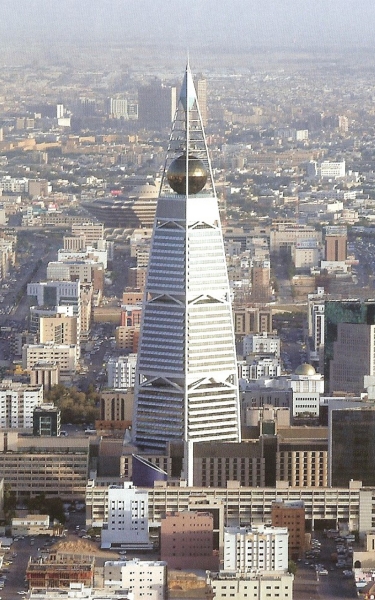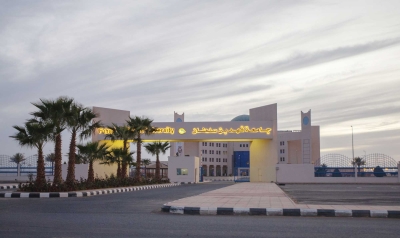
Al-Faisaliah Tower is the first skyscraper in the Kingdom of Saudi Arabia, standing at a height of 267 m. At the time of its construction, it was taller than any European building. Located in al-Olaya district of Riyadh, its construction began in 1997. The building project was inaugurated by the Custodian of the Two Holy Mosques, King Salman bin Abdulaziz Al Saud when he was the Prince of the Riyadh region. The tower, which weighs 10,500 t, was officially opened in 2000.
Al-Faisaliyah Tower includes 30 floors of corporate offices, restaurants, service facilities, event and conference centers, a five-star hotel spanning eight floors, and four floors of shops with 100 showrooms.
Al-Faisaliah Tower design
Al-Faisaliyah Tower, which spans an area of 34,000 m2, consists of five sections: al-Faisaliyah Tower, the Commercial Center, the Conferences and Banquets Center, al-Faisaliyah Hotel, and residential apartments. The al-Faisaliyah Tower's architecture reflected the technology of its time and utilized modern tools. This tower was the first of its kind in Saudi Arabia, marking the beginning of an era in architecture that embraced the latest technologies while still considering the social and cultural context of the time.
The design of al-Faisaliyah Tower is reminiscent of the details of the historical minaret of the Omar bin al-Khattab Mosque in al-Jawf Province in northern Saudi Arabia. At the top of the tower, a glass sphere with a diameter of twenty-four m was added, which can be seen from all parts of Riyadh. The British architect Brian Clark designed the frosted tempered glass for the tower's facades, with its colors blending to reflect the environmental diversity of Saudi Arabia.
A local real estate company managed two sections of the building: al-Faisaliyah Tower and the Commercial Center. Meanwhile, another company managed the al-Faisaliyah Hotel, the Convention and Banquet Center, and the residential apartments.
Challenges during construction
Environmental challenges were the most prominent issues faced during the construction of al-Faisaliyah Tower. A local construction company underwent additional procedures, testing limestone before pouring the concrete foundation. This continuous pour lasted for seventeen hours, reaching a depth of fifteen m underground. To ensure no gaps, caves, or voids, they drilled one thousand holes into the limestone to a depth of thirty-five m, even though the construction plan required only five m for most of the holes. This was done to guarantee that there would be no cracking in the tower's infrastructure.
The tower's base used a particular type of cement to fill the rocky cavities. This was done anticipating soil cracks that might result from climatic factors. Additionally, all foundations were lined with an insulating rubber layer due to the high groundwater level in the land on which the tower stands.
It was expected that the top of the al-Faisaliah Tower would tilt by 450 mm over three years due to winds. Although this tilt is a natural physical phenomenon, the tower's design considered the need to withstand high wind speeds estimated at 140 km/h.
Energy and communications supply
The electricity needs of al-Faisaliah Tower building amount to twenty-seven MW, and its facilities have been extended with a capacity of about fourteen thousand volts. Although this number is considered relatively large, al-Faisaliah Tower uses less energy per m2 compared to similarly-sized complexes. The tower also utilizes five thousand telephone lines, coordinated for the tower by the Saudi Telecom Company (STC), sufficient to supply a small city. This required a direct optical fiber network connection to the tower's local exchange.
The original concept
Prince Bandar bin Saud al-Saud, the Secretary-General of the King Faisal Charitable Foundation, proposed the idea of establishing al-Faisaliah Tower to the foundation's members after a series of nominations that included global engineering companies, two prominent British firms renowned in engineering investments participated in the tower's execution. These were Foster and Partners and Buro Happold. The design details of the tower in Riyadh were overseen by the British architect Norman Foster, who also designed Stansted Airport and the Millennium Bridge in London.
Related quizzes
Related articles


